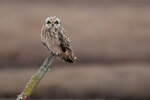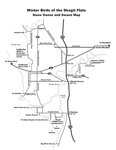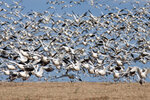





The single best Puget Sound birding area, in my view, is the Skagit Flats, located west of I-5 north of Everett. And the single best time to go there is now, in winter. That’s because this broad, flat floodplain of the Skagit River is used extensively for commercial agriculture (think of the Skagit Tulip Festival each spring) and as a habitat for migrant birds in the winter. (There are numerous websites about birding the Skagit Flats – just type “Skagit Flats Birding” into your search engine.)
This area can be visited as a day trip, although given the short days of winter, you might want to plan an overnight stay at one of the many nearby lodges and inns. I usually leave I-5 at Conway and wander west and north along the many secondary roads. The northern edge of the best birding area is State Highway 20.
Driving straight west from Conway on Fir Island Rd. takes you to the Fir Island Farm Reserve, a short trail with good bird habitat.
As you drive along at a slow pace, you will encounter many waterfowl flocks of varying sizes. The stars of the show are the Snow Geese. These large birds are all white, with black wing tips.
A specific Snow Goose population winters here. Their breeding territory is on Wrangel Island in the Chukchi Sea, north of Siberia, Russia. Each winter, some 150,000 migrate south to the flat agricultural areas of the Skagit River and the Fraser River in British Columbia. There is no more magnificent sight for a birder than a huge flock of Snow Geese rising from their feeding field in response to being harassed, likely by a Bald Eagle.
The Skagit Flats also hosts the largest wintering population of Trumpeter Swans anywhere – some 7,500 last year. You can easily separate swans from geese by the swan’s very long neck. In addition to Trumpeters, there are also smaller numbers of the Whistling subspecies of Tundra Swan. The two species are similar – depending on your bird book and binoculars to help you spot the subtle differences.
There is an abundance of other, more common waterfowl, too. And sometimes, the flocks of ducks are huge and impressive.
Keep in mind, also, that the Skagit Flats has popular waterfowl hunting locations. If you keep to the roads and recreational access areas, you should not be in conflict with hunters, although you possibly will hear shooting in the distance.
Where there is abundant habitat (and prey), there will be abundant predators. You will see many Bald Eagles, Red-tailed Hawks, Northern Accipiters and possibly the occasional falcon (the old-time name for Peregrine Falcon, after all, was Duck Hawk).
There is also a chance that you will see owls. The Short-eared Owl is active in daytime hunter, soaring low over open fields looking for voles, its favorite prey. Notice its stubby face and wide head, and wings arced upward. Some years, there are many Snowy Owls at Skagit, but not this year (at least so far). And, if you are driving around at dusk, look for the profile of a Great-horned Owl profiled against the still bright sky.
All is not good bird-watching news, however. The last decades have brought about the closure of a number of dairies. Dairy farms provide excellent waterfowl habitat and the birds do not conflict with farming activities. This lack of conflict does not always prove true for successor farming activities; a sod farm, for example, would prefer to have no visiting waterfowl.
Also, sometimes birders cause conflicts with agriculture, too. Some people walk or drive on farm roads to “get a better look.” DON’T DO IT! Stay on the edge of roads and approved nature trails. This is a large area and, just by driving around patiently, you will encounter many interesting avian sights.
Finally, I want to mention a good location just north of Highway 20, Bay View State Park. This park is on Padilla Bay, a rich marine area, and hosts marine birds that you will not find on the flats, including the Common Loon. One bird I like to look for is the Black Brant. Brant are smallish geese with black bills, heads and breasts, and there’s a Pacific subspecies that is much blacker. You will see them bobbing along the shoreline, feeding on eelgrass and the like.
As I reported earlier, our 16-year-old photographer, Liam Hutcheson, has set a new record for Washington by documenting 378 bird species in 2023. For his lifetime, Liam is now at 400 species for the state. For 2024, Liam tells me that he will be focusing on other goals, including visiting birding hot spots in other parts of the country. But I bet he will continue to seek out those rare vagrants that occasionally visit our state.
George Walter is environmental program manager at the Nisqually Indian Tribe’s natural resources department; he also has a 40+ year interest in bird watching. He may be reached at george@theJOLTnews.com
Photos for this column are provided by Liam Hutcheson, a 16-year-old Olympia area birder and avid photographer.
2 comments on this item Please log in to comment by clicking here
wildnature
Thank you. You have given new meaning to me for the Skagit flats which I've driven by for years. I've always noticed the snow geese, but never imagined they winter here from the sea north of Siberia! Thank you George for sharing your knowledge.
Best,
Jean Shaffer
Friday, January 5 Report this
CPRanger1966
Thanks so much for this and your other delightful articles - and for Liam Hutcheson's photos. Your practical advice on visiting the Skagit Flats is just what I needed to plan a visit there. Best regards - Cleve Pinnix
Friday, January 12 Report this